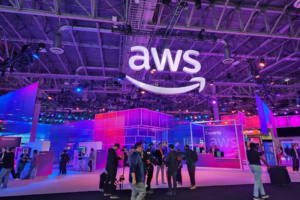Leading-edge companies in fashion, gaming and sustainable industries are working the cloud to eclipse the competition
It’s hard to grasp just how pervasive the transformative effects of the cloud have become. From buying groceries to taking out insurance, few activities in modern life remain untouched by cloud innovation.
The sheer scale and variety of what’s happening make it impossible to do any kind of comprehensive review of how the cloud is changing the world. Instead, we’re taking a look at some of the ways the cloud is driving rapid change in three dynamic industries.
Sustainable industry
Responsible businesses in all industries know they need to tackle the challenge of environmental sustainability. Further incentivized by the prospect of shrinking the financial burden of climate change, they often focus on reducing the energy consumption required to manage increasingly powerful computing engines, expanding storage demands and the need for always-on customer services. One of the benefits of migrating infrastructures to the public cloud is that it reduces energy consumption substantially and can cut carbon dioxide emissions by up to 59 million tons annually.
But the cloud has applications for sustainability that go far beyond cutting energy consumption: Innovative organizations in a wide range of industries are discovering just how to harness the cloud to save resources and mitigate climate change.
Renewable energy
The industrial Internet of Things (IoT) is a key cloud-driven technology enabling the expansion of the renewable energy sector, particularly in areas where it is applied to instrumentation and sensor control. IoT systems remotely regulate the dual-axis trackers used to maximize solar radiation during daylight hours, and they can also be used to monitor power generation in wind energy.
Next-generation energy systems known as smart grids incorporate wireless devices such as sensors and radio modules to drive more efficient resource use. IoT technology enables connected devices to communicate and respond to demand. Smart grids can now support manual switching between renewables and established power plants to counter the unpredictable nature of solar and wind energy and ensure a reliable supply to customers.
Cloud computing also allows energy companies to harness the vast amounts of data they are generating to gain valuable insights into how they can improve their offerings. Israel-based Raycatch uses Google Compute Engine and Google Cloud Bigtable to power the daily data analyses it conducts to help utilities optimize the functioning of their solar assets.
Other applications include grid inspection, like how Axpo, Switzerland’s largest renewable energy provider, uses the AI-based Grid Vision from eSmart Systems to enhance the reliability of supply, employee safety and cost-efficiency. Grid Vision embeds the data it collects with drone images and notes about issues that might need attention. This helps to maintain a reliable power supply because there is no need to take lines out of service if a problem is flagged.
Nourished soil
Sustainability places a justifiable emphasis on sourcing viable alternatives to the energy we drill out of the ground, but the ground itself also deserves attention. Farmers often lack proper insights into their soil conditions, so their irrigation and fertilizer application is ad-hoc, wasting valuable resources and limiting yield potential.
Realizing that fewer than 10% of agricultural companies get data from the soil itself, agricultural analytics company CropX captures data from thousands of global soil sensors and sends it to a centralized platform running on hundreds of cloud instances. The platform integrates this data with a range of above-ground data layers such as satellite imagery, weather, topography, crop models and user inputs in real time. AI-based algorithms then process the data and deliver irrigation and crop nutrition recommendations via the CropX web or mobile app.
Reducing carbon footprint with synthetic biology
DNA pioneer TeselaGen is collaborating with LanzaTech, which recycles carbon into products such as carbon-negative biofuels, to incorporate artificial intelligence capabilities in Lanzatech’s biological design platform. TeselaGen has developed a cutting-edge cloud-based solution for designing, building and optimizing complex biological workflows and products. Working together, the companies aim to reduce the human carbon footprint by harnessing TeselaGen’s platform for modern industrial DNA design and cloning to scale up Lanzatech’s R&D operations dramatically.
The urgency around cutting carbon emissions is accelerating, and pressure is mounting to optimize processes for recycling more and more carbon. Working together, Lanzatech and TeselaGen have developed an operating system for biotechnology that can interoperate with existing infrastructure and services. This enables faster iteration, reducing costs and time to market.
These are just a few of the myriad use cases that illustrate not just the inherent sustainability of cloud infrastructure but the centrality of cloud-enabled innovations to sustainable solutions.
Gaming
Harnessing cloud technology for gaming allows players to stream an almost limitless range of games to their computer or mobile device for a set monthly fee, eliminating platform barriers such as storage space and the need for specialized equipment. Key players in the cloud gaming space, such as Microsoft, Google, Amazon and Nvidia are still learning how to balance a workable business model with a quality gaming experience unspoiled by network latency. If they get it right, the cloud could become the future platform of choice for players. Indeed, the cloud gaming market is forecast to reach $ 9.4 billion by 2027, a CAGR of 48.3% from 2022.
The advent of GPU-as-a-Service (GPUaaS) is helping to supercharge this ever-evolving industry. Graphic process units (GPUs) are integral to the design of high gaming resolutions and system build because they boost the quality of visual content and reduce microprocessor load. GPUaaS leverages cloud technology to enable hundreds of graphically intensive games to stream concurrently at high frame rates, reducing latency.
However, the future of cloud gaming may well be dictated, not by advances in technology, but by the human appetite for change. Until gamers abandon their preference for physical gaming consoles and games, cloud gaming will continue to lag behind traditional gaming methods.
Fashion
E-commerce and automation are not the only cloud-enabled technologies the fashion industry is embracing. The rise of online and contact-free shopping is likely to continue even after the pandemic, and the cloud is also creating opportunities for more exciting innovations in this sector.
Take Eon, which is turning products into intelligent assets by connecting them to digital IDs through its cloud-based Platform-as-a-Service. The EON Product Cloud is an IoT platform designed to build a “connected products economy” – a digital system for fashion and retail companies to connect with their customers by giving every garment in the world a digital twin to track its lifecycle and value. This will give brands the data and insights they need to develop lasting relationships with their customers, as well as the necessary systems to adopt new business models, including rental, resale, recycling and styling services.
Cloud computing has also created new avenues for collaboration among factories, distributors and other companies in the supply chain. With 24-hour, real-time access to relevant data, links in the chain can communicate faster and more effectively – something that is vital in a world where the value of cloud-based supply-chain management solutions will surpass $11B by 2023.
Supply-chain platform Suuchi Inc. provides a cloud-based technology called the Suuchi GRID for full visibility of the supply chain, from design to distribution. This allows fashion brands to manage risk across their supply chains through data analytics, accessing real-time updates direct to their devices.
On the fashion production line, Techpacker’s cloud-based software alerts everyone involved in design and manufacture to changes in tech packs (the blueprints created by a technical designer) in real time. This streamlines the process, making tech pack creation 70% faster than traditional methods.
Cloud-enabled AR and VR technology are also making inroads in the fashion industry. The OBSESS platform allows customers to experience stores and brands in a 3D, 360-degree setting rendered on websites, mobile apps and social channels via a 3D commerce cloud.
EFI Optitex uses AR/VR technology to make it easier to find a proper fit. It transforms 2D sketches and technical patterns into simulated 3D renderings, which can then be adjusted in real time for a precise fit.
Limitless possibilities
It’s easy to get overwhelmed by the sheer scale and range of innovations the cloud is enabling across industries and customer experiences worldwide. And while there is no clear theme among the myriad new ways of designing, producing and delivering products and services, all of them share a focus on extracting more value from fewer resources.
Whether it’s an IoT system optimizing energy supply in line with demand or data analysis to produce insights to extend the life of a product, the cloud is allowing smart people in businesses everywhere to maximize the potential usefulness of their offerings. Simply applying cloud technology does not make something great, but harnessing the cloud to deliver on its promise certainly enables greatness.








